#vicky's vritings
Text
At the Prehistoric Planet watch party last night, someone made a really interesting point: if a maniraptoran dinosaur had survived to the present day, we'd almost certainly think of them as the bird equivalent to monotreme mammals. They wouldn't be seen as a different group - they'd be 'those weird birds with the teeth and tails who can't fly'. The same way you'd never classify a platypus or an echidna as anything but a mammal - just a rather peculiar one with a bunch of strange primitive traits - our definition of bird would just be a bit wider.
In fact, the common ancestor of dromaeosaurs and birds lived more recently than the common ancestor of monotremes and other mammals!
#evolution#palaeoblr#bird#dromaeosaur#monotreme#also this sounds like a really cool world#vicky's vritings
660 notes
·
View notes
Text
Happy New Year!
Let's imagine it was the Earth itself that was going into its 2024th year. That is to say, we're compressing the entire history of the Earth into just the past 2023 years. What events would have happened when?
Well, not too much is certain about the first couple decades after our planet formed, until around 50 CE when we were hit by another proto-planet, Theia, and the debris formed the Moon. After a couple years of the planet cooling down again, the oceans formed out of boiling rain. The timing of the origin of life is very uncertain, but there are chemical signs it may very well have happened as early as the second century. Around 200 CE, the gas giants did a big funky orbit-swapping dance, and in the process inflicted the Late Heavy Bombardment on the rest of the solar system, meaning the Earth was suffering a ton of meteorite strikes for the entire third century.
The first indisputable evidence of life is from around 330, and the first stromatolites appear around 470. Those are basically the first fossils, stones created by layer upon layer of oxygen-producing cyanobacteria living and dying on top of one another. But even with oxygen producers evolving, it would take many centuries before oxygen became a major part of the atmosphere: not until the Great Oxygenation Event, which happened during the ninth and tenth centuries. That's also about the time the first complex, eukaryotic cells evolved through a symbiosis between an anaerobic archaean and an oxygen-breathing bacterium. The bacterium became more and more focused on just the oxygen-breathing task inside the larger cell, until its descendants were mitochondria, which as you all know are the powerhouse of the cell. The next seven centuries passed by with only slow, gradual changes, and life continuing to be unicellular and difficult to find in the fossil record.

(1735's Snowball Earth, by me)
From 1704 to 1730, the entire planet froze over. After merely two years of thaw, it happened again, this time lasting from 1732 to 1742. But these snowball Earth episodes set the stage for the evolution of animals that began right after. Across the mid-18th century, the bizarre Ediacaran biota, with its strange symmetries, fronds, and fractal-like pattern filled the oceans. In the early 1780s they went extinct, possibly due to a temporary drop in oxygen-levels, only to be replaced by a great variety of quite different creatures in the Cambrian Explosion.
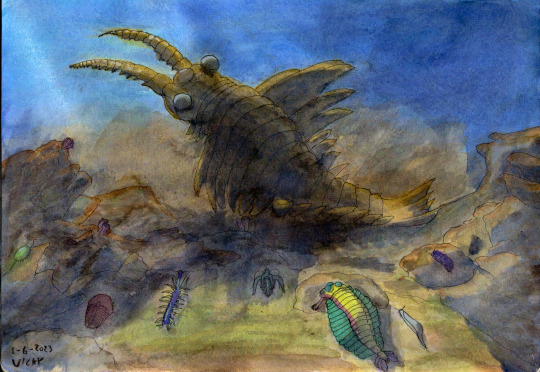
(Class of 1799, by me)
Starting in 1784 and running for a few decades, the Cambrian period saw the origin of most of the modern animal phyla, reaching its most famous form in the Burgess Shale fauna of 1799. During this time, most animals still lived on the sea floor, either attached or crawling, with relatively few actually swimming creatures. Plants started tentatively moving onto land around 1817, and in 1825, the rising of the great Appalachian mountains caused a severe drop in global CO2 and thus temperatures, leading to the Late Ordovician mass extinction.

(Horseshoe crabs and sea scorpions on a beach in 1834, by me)
Bony fish first showed up during the 1830s, and around the same time plants were getting serious about inhabiting the land, evolving roots and vascular tissues so they could properly grow there. Millipedes and the ancestors of spiders were the first animals to follow them onto land. Our own fishy ancestors did not take their first step until 1857, by which point the arthropods were well established there and the plants had figured out how to become trees. The Late Devonian extinction, partially caused by the evolution of said trees and partially by the south pole freezing, played out in two pulses over the late 1850s and early 1860s.
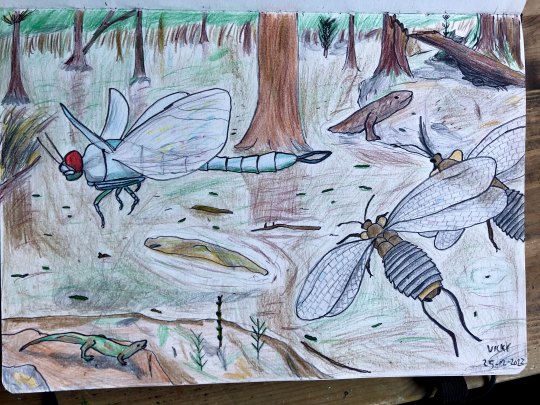
(Swamp prominently featuring Meganeura and Mazothairos in 1889, by me)
Arthropods and vertebrates continued to gain adaptations to life on land. The insects became the first creatures ever to fly in 1878, and the high-oxygen atmosphere of the time would be especially good to them. Around 1884, a group of vertebrates called the amniotes, after the membrane that kept water inside their eggs so they could lay them on land without them drying out, split into two groups: the reptiles and the synapsids (which we mammals descend from). The next few decades would see the synapsids in particular being extremely successful as the supercontinent Pangaea formed. Until 1912, when a massive episode of volcanism caused the worst mass extinction of all time, the Great Dying, scouring the Earth of a huge portion of its life.
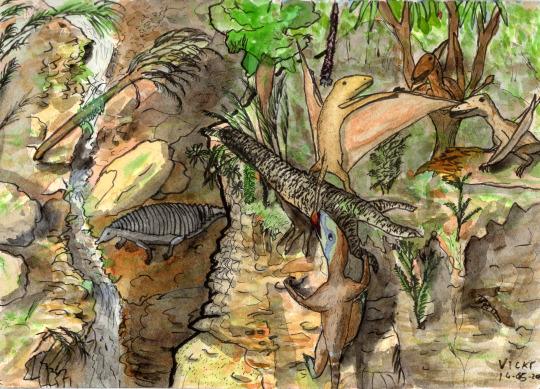
(A 1930 scene featuring the three branches of archosaur: dinosaur, pterosaur, and pseudosuchian, by me)
The 1910s were a period of slow recovery during which strange new forms of animal evolved. Many different, unrelated reptiles, such as the ichtyosaurs and plesiosaurs, went to sea, where they would continue to provide some of the most impressive creatures for most of the 20th century. On land, the dinosaurs first appeared in 1920, though for the next decade or so they'd live in the shadow of their pseudosuchian (crocodile-line) cousins. In 1934, Pangaea began to break up, resulting in another terrible pulse of volcanism that caused a lot of extinctions and left particularly the feathered and furry survivors with a lot of empty niches to fill, allowing the dinosaurs and mammals to diversify greatly. The last common ancestor of all modern mammals lived in the early 1940s, and by 1957 the dinosaurs had figured out flight, with Archaeopteryx usually being considered the first bird. Other dinosaurs took on an incredible variety of sizes, shapes, and forms. Some of the most famous ones include Dilophosaurus (1942), Diplodocus and Stegosaurus (1955), Iguanodon (1969), Velociraptor (1991), and Tyrannosaurus rex (1994).

(A tropical lakeside in the year 2000, by me)
In 1995, the world was struck by a meteorite, wiping out many groups, including the marine reptiles, pterosaurs, and ammonites. The surviving mammals and dinosaurs went on to diversify across the next couple of years and had formed thriving new ecosystems in the tropical world of the turn of the millennium. The first known bat lived in 2001, and the whales returned to the oceans next year. Around 2009, the world's climates turned colder and dryer. Antarctica froze over and grasslands spread widely. Our last common ancestor with the chimpanzees and bonobos lived in 2021, and by new year 2023, our ancestors were getting brainier and more proficient with tools. That's also when the north pole froze and the Quaternary ice age cycle began. The first known members of Homo sapiens lived on 10 November 2023. The latest ice age started on 14 December, and ended at 2 AM on 30 December. The great pyramid of Giza was built at 6 AM on 31 December and On The Origin Of Species was published at 23:22 PM.
#palaeoblr#happy new year#2024#geologic timescale#vicky's vritings#one year is 2.244 million years if you're curious#and yes i did exclude both year 0 and 2024#since 0 doesn't exist and 2024 hasn't happened yet#my art#i rather enjoy having an extensive collection of my art to illustrate my paleorambles nowadays#incidentally the big bang occurred in 4121 bce at this scale#which is curiously close to the date of creation creationists made up#if only they would follow through and insist humanity itself was seven weeks old too
124 notes
·
View notes
Text
Let's take a closer look at the hominin skulls in the Senckenberg Museum's human evolution room. Keep in mind this is not a linear progression through our ancestors, and more like a bunch of closer and more distant cousins.


The first one, Sahelanthropus tchadensis is seven million years old, and may very well not be a hominin at all. I've always leaned towards the hypothesis that it's a gorilla relative, not one of ours. No matter which branch of the apes it belongs to, it lived not long after the time the human-line (hominins) and the chimp-line separated, and possibly even before that point!


Ardipithecus ramidus, the first hominin from where we can start making a fairly decent family tree of our relatives. Before this point, 5 million years ago, hominin fossils are very rare, fragmentary, and difficult to assign. One of the most interesting things that does seem to emerge from these early fossils is that we have walked on two legs for a long time. Maybe even so long that our common ancestor with the chimps and bonobos did it!

Lucy represents Australopithecus afarensis, who shows up at this point (3.3 million years ago).


Australopithecus africanus, the Taung child to be precise. We're about 2.8 million years ago at this point. Australopithecines must've been such fascinating creatures.
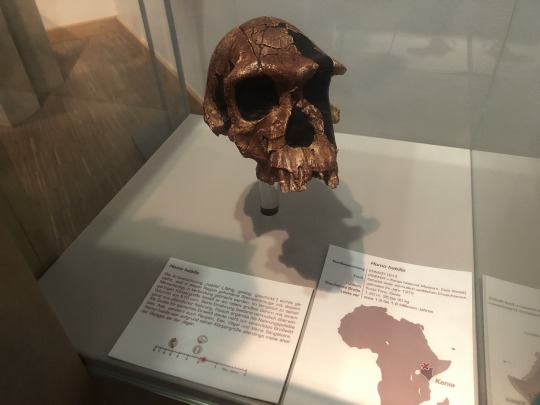

Homo habilis, the 'handy man', named that way because when they were discovered they were thought to be the first humans who used tools. Since then, Australopithecus tools have been found, and tool use by many different animals has also been documented.
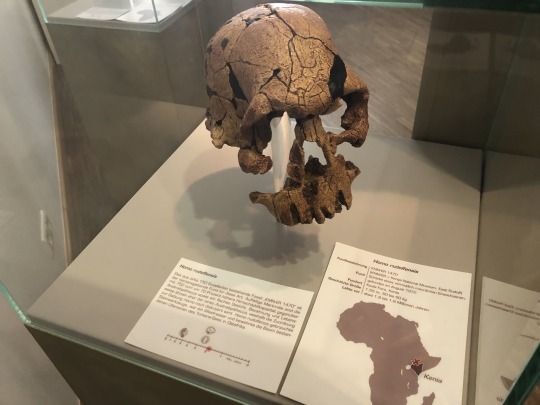

Homo rudolfensis, a population of humans who lived at the same time as Homo habilis and were notably bigger and a little brainier. Does it warrant being its own species? That depends who you ask. Splitting vs lumping is a point of contention in almost every group's biology, and it can run especially high in the field of human evolution since hominins are A very high profile and important fossils that directly relate to our own origins, and B an extremely tangled group that seems to have produced loads and loads of isolated populations and subspecies that regularly migrated all over the place and had frequent interbreeding events. Personally I tend to come down on the side of lumping them into a few major species.


Paranthropus boisei. These were basically a separate lineage of australopithecines, quite different from our own ancestors, who continued to do australopithecus things until quite recently. They were very good climbers and seem to have returned to the trees.

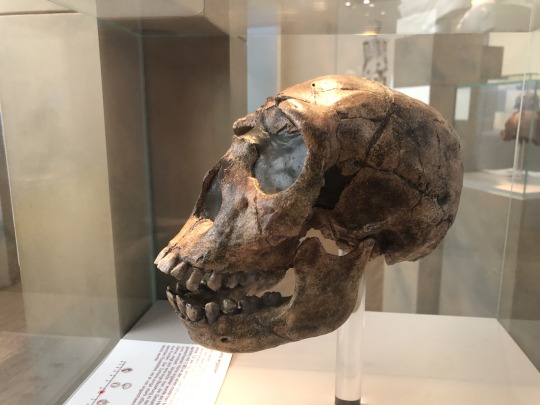
Homo ergaster, either a close relative or a synonym of the more famous Homo erectus. This is the point where we got really brainy, probably figured out how to make fire ourselves, and spread from Africa to Eurasia.

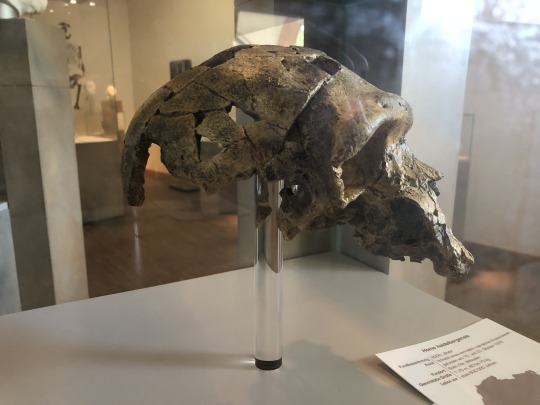
Homo heidelbergensis. Homo erectus and its many subspecies spread all over Africa and Eurasia and existed for well over a million years. As time marches on and evolution did its thing, we eventually start calling the ones in Africa Homo heidelbergensis. They were quite tall, positively enormous compared to little Lucy a few million years back, and they too joined in the human migrations out of Africa. From the H. heidelbergensis who moved into Eurasia we eventually get neanderthals and denisovans, while Homo sapiens evolved from the heidelbergensis populations in Africa.
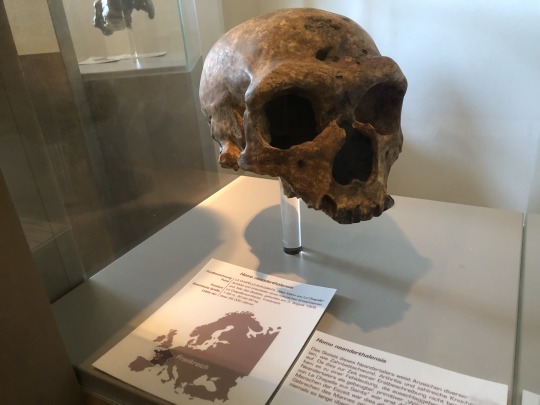

And there's the neanderthals! Large-brained and creative (the first known cave paintings belong to them and they buried their dead), they were likely quite different from the brutish image we often get from them. Rather than truly dying out, their populations eventually merged with the larger Homo sapiens population once they migrated out of Africa, leaving our modern genes with a couple percent neanderthal DNA.
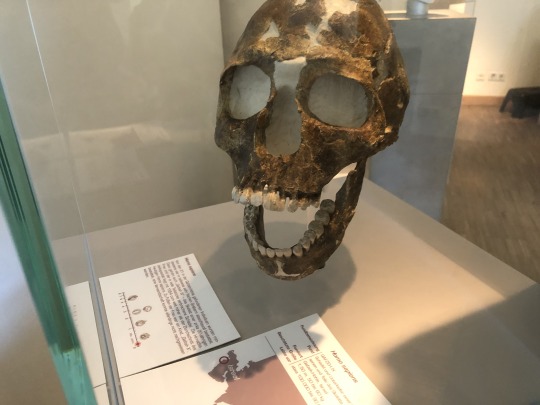
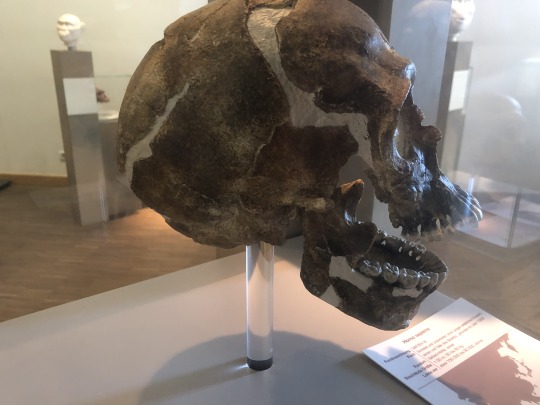
Homo sapiens. And that's us! Not so much the last remaining branch of the human family tree as much as several of the separate branches ended up coming back together and weaving into a single bigger branch.
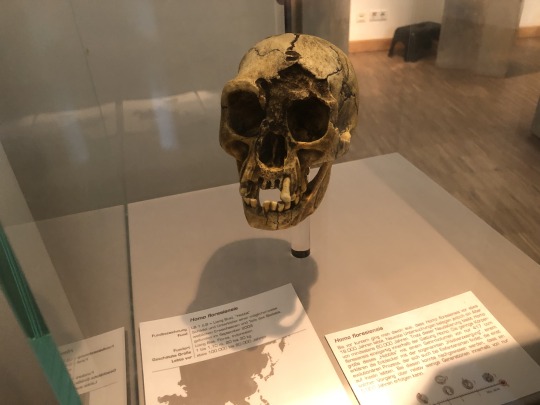

And then there's these little guys, Homo floresiensis! Probably originating from a Homo erectus population that ended up on the island Flores, insular dwarfism ended up making them grow quite tiny. On their isolated island, they remained until about 50000 years ago.
#human evolution#sahelanthropus#ardipithecus#australopithecus#homo#ape#primate#mammal#neogene#quaternary#palaeoblr#senckenberg museum#vicky's vritings
328 notes
·
View notes
Text

(Image, as well as much of my information, from Carboniferous Giants and Mass Extinction by George R. McGhee Jr.)
Take a look at this tree. On a scale of 1 to 10, how weird do you think it is?
You quite possibly just gave it a 3 or a 4 or something. Sure, it's a little odd, but does look vaguely normal, right? A friend of mine guessed it was some sort of baobab when I showed him the image.
This is, in fact Lepidodendron, an ancient tree from the Carboniferous, and by modern tree standards it is absolutely bizarre. Its closest surviving relatives, quillworts and clubmosses, only grow to a height of a few centimetres, yet Lepidodendron were giants that shot up to 50 metres tall... Briefly, before dispersing their spores and completely dying off.

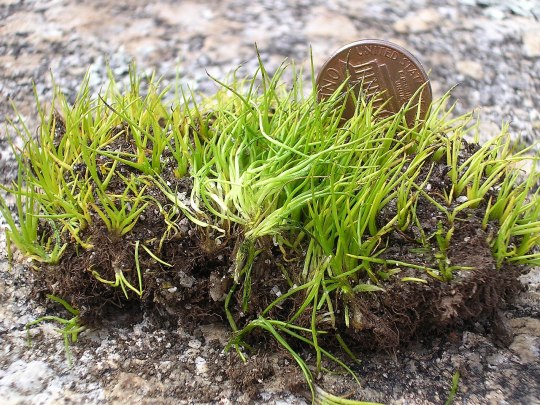
(Lycopodium and Spinulum, modern relatives of Lepidodendron, photos by Bernd Haynold and Pete Pattavina)
You see, Lepidondron lived like a gigantic dandelion. For most of its life, it was a stumpy little thing that stuck close to the ground. Just an odd scaly green stump with some long leaves poking out. The green scales its bark consisted of were the place it conducted its photosynthesis, and thus basically did the work of leaves. The Lepidodendron would stay like this for a couple years, slowly expanding its roots and getting ready for the next step. But its roots would grow mostly horizontally, down not so much! And part of why is that even they had the scaly leaf-like photosynthetic bark. That's right, even their roots could - and to some extend needed to - photosynthesise!


(Fossil Lepidodendron bark in the National Museum of Brazil, photo by Dornicke; a fossilised relative of Lepidodendron with some of its roots visible, photo by Michael C. Rygel)
So why would you ever try to photosynthesise with your roots of all things as a plant? Surely it would make much more sense to just transport the sugars created in other parts there than to have your roots be so shallow that bits of them can catch a little light and make it in situ? Sure, if you're capable of that! This is what modern trees do, but they have two separate vascular tissues they use for transport: xylem, which moves water from the roots to the rest of the plant, and phloem, which moves sugars and other photosynthetic products from the leaves to the rest of the plant. Unfortunately for Lepidodendron, it only had xylem, no phloem, so its sugars were only ever going to move as far as they could diffuse, so every part of the tree needed to have at least a little photosynthesis happening, even the roots.
This truly gets ridiculous when the Lepidodendron decides after a few years of charging up that it's time to reproduce. That's when the weird green stump we have so far starts shooting up, up, up, very quickly, all the way until an enormous 40 or 50 metres in height. Now, modern trees grow this large by being supported by a sturdy wooden core, but that's not what Lepidodendron did. To hold up the entire tree, it relies entirely on its outer bark thickening as it grows. In mechanical terms, it was little more than a huge hollow pole, probably creaking and swaying terribly in the wind. Although I have not been able to confirm this in the literature so far, I suspect that between the shallow roots and the whole thing being held up by its bark, you could probably total a Lepidodendron with a good kick.
Now remember, all this growth is happening without phloem, so the entire length of that stem has to not just be sturdy enough to keep the tree standing, but it also has to keep doing photosynthesis to feed itself. When it reaches its full height, the top of the tree finally starts sprouting branches and small leaves, leaving it looking like the picture at the start. But those are not what it's all about for the tree: the cones that develop among them are. At a height of 50 metres, the spores produced by the cones can very easily be picked up by the wind and blown far, far away. Being spores, rather than seeds as modern trees have, they have no supplies built in whatsoever, so they need to get lucky to land in a spot that has immediate access to water. Luckily, there are a lot of those in the vast Carboniferous swamps, and with the trees doing so much work to spread the spores very widely, some of them are sure to find good spots. And then, with the spores dispersed, the tree is done for. The entire thing, which has just grown to the skies, dies off and soon comes crashing down.
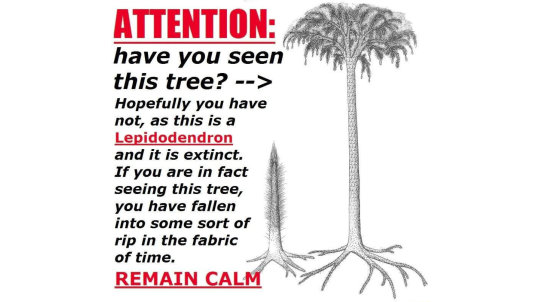
So how weird is this tree? I'd call it a perfect 10.
131 notes
·
View notes
Text
Something unexpected that I really love about Prehistoric Planet is how it stays in a single period in time and explores it, rather than trying to cover the entire Mesozoic and show the world changing. If you showed an alien the programme with the intro cut out and the title censored, they probably would never even guess it was a show about a distant time in Earth’s past. In just being a wildlife documentary that happens to be set 66 million years ago, it’s showing the Maastrichtian world as a living, full-formed, very real world that existed for an unbelievably long time, rather than a phase in an even longer evolutionary process. Now don’t get me wrong, I love wide sweeps of evolutionary history like Walking With Dinosaurs too, but Prehistoric Planet’s vibes are very different and I never knew I needed them. In fact, I’m really hoping we won’t even see a trace of the meteorite in episode five. Let me just go on a little tangent to really get into why.

This is Trix the T. rex. I saw her in the Naturalis natural history museum. She lived and died 67 million years ago. Now, it is very easy for me to see that date and be filled with a sense of impending disaster. ‘Just before the end’ is a thought that quickly appears. But when you really think about it, that’s ludicrous. Trix lived her life, and then after she died her species continued to thrive for a million years. There’s thrice as much time between her and the Tyrannosauruses who died in the K-Pg extinction as there is between me and the first members of my species! And as for the thousands of years of recorded human history, those are a mere drop in that sea of time. Those years didn’t pass any faster back then than they do now, nor were they any less real. There were just as many moments in any one of those thousand millennia between Trix and the meteorite as there were in the millennium between me and Basil the Bulgar-slayer. If a wizard told you your species and your world would continue to thrive for a million years before eventually most of your clade would get wiped out by a terrible catastrophe, would you see your world as a doomed and temporary one about to go over a precipice? I think I would be delighted to know we have such a vast sea of time left.
This got longer and more philosophical than I expected, but the point is that I love the focus on the Maastrichtian as a diverse, living world, rather than the last age of the Mesozoic. We don’t know whether Prehistoric Planet is set a million, fifty thousand, or nine hundred years before impact, and it doesn’t really matter either. Even though all those dates are, geologically speaking, so close to the end of the Cretaceous we could barely tell the difference between them, they all have more time left than any of the animals can possibly conceive of. None of the animals we see in Prehistoric Planet have ever seen a Stegosaurus, and none of them will die as a consequence of a meteorite striking the Earth.
#prehistoric planet#dinosaur#tyrannosaurus#vicky gets emotional and philosophical about dinosaurs#extinction#vicky's vritings
3K notes
·
View notes
Text
Thinking about the Boring Billion. From 1.8 to 0.8 billion years ago, not much changed about life on Earth, nor even about the abiotic conditions of Earth itself. Earth, it seemed, had entered stasis. She was a planet almost three billion years old, her fiery Hadean childhood long behind her. The Archaean eon had brought water and life, had made her unique among her siblings. The young Earth had evolved many different kinds of prokaryotes, doing all sorts of fascinating things, making and using sulphur, methane, carbon dioxide, and eventually oxygen. Her atmosphere transformed, her skies turned blue, her oceanic iron settled into minerals, and life evolved symbiosis to grow into new, larger eukaryotic forms perfectly adapted to the oxygen. There were even some brief, quickly abandoned experiments with multicellularity. Earth was a bright young planet full of promise.
And then... nothing. As poised as the Earth seemed for her next big thing, it just didn’t come. She kept on spinning around the Sun as she always had, and her life, as chemically intricate and beautiful as it was in its own way, kept on doing largely the same things. What developments there were seemed slow, small, perhaps taking far longer than they needed to. And as the long ages of the Proterozoic stretched into a billion years, life on Earth, it seemed, was all it ever would be. Blue skies, blue seas with fascinating little unicellular creatures under their surface, and rocky continents dancing their slow tectonic dance. It wasn’t a bad existence, to be sure, and it must’ve been difficult to imagine it ever changing. After all, over a quarter of the planet’s existence had been like this. Earth’s future looked to be a few more billion years of it before her eventual fiery end.
But long before the Sun’s fire came for her, it was ice that finally broke the Earth. As she neared her fourth billion, the worst ice age Earth ever experienced came over her. Whether because of an unfortunate configuration of continents, a big shift in atmospheric gases, a lack of volcanism, a fluctuation in the Sun, a shift in her orbit, or some combination of these, the Cryogenian period brought glaciers all the way down to the equator. Earth, so full of life and wonder once upon a time, now looked like distant frozen Europa as the worst crisis since the Late Heavy Bombardment turned the planet into a glacial grave. And just when the ice retreated, when it seemed like things were looking up - the planet immediately froze over a second time.
But her life was tenacious and somehow clung on, in the liquid oceans below the ice and in the rare open seas around the equator. And when the ice thawed a second time and warmth returned, Earth did not return to her old stasis. When her life retook the formerly frozen wastes, it developed new tricks, new forms, spurred on by an atmosphere now more oxygenated than ever before. Multicellular life, mere experimental playthings in the past, became Earth’s hallmark and soon filled her seas with animals, plants, and fungi. Fronds bloomed on the sea floor and gelatinous blobby creatures wandered in between them and they were like nothing that had ever appeared before. The Earth bloomed with this new life for a time.
But it turned out she didn’t get it quite right, ran into a dead end, and the Ediacaran garden withered as suddenly as it had bloomed. But from its remnants, a second attempt at animal life came, very different than before yet building on its successes and failures. And this time, it seems, everything just clicked. From so simple a beginning, endless forms most beautiful and most wonderful evolved, every one of them begetting a hundred new possibilities, starting a runaway chain of creatures that would soon turn the bare continents green and even soar in the skies. After four billion years, the Earth finally reached the beautiful and unique potential that had been so unimaginable during those billion years that lie so far in the past and are so easily forgotten now.
#proterozoic#boring billion#evolution#palaeoblr#cambrian explosion#with all due respect to the prokaryotes who i know are still the most numerous and diverse beings on earth#earth suffered from gifted kid syndrome but then had a middle-age glow-up#so if you're currently experiencing your boring billion or cryogenian period:#you'll find your cambrian explosion some day#vicky's vritings
117 notes
·
View notes
Text
When someone dismisses birds being dinosaurs as a technicality, a bit of taxonomic pedantry, it kind of makes me sad. Because I would love for them to see how very true and beautiful it is.
Two centuries ago, we started figuring out some of the fossils in the ground were remnants of strange, mysterious prehistoric beasts. We found more and more different kinds of them, with frills and horns and armour and giant teeth and bizarre headgear and vicious claws and some bigger than any other land animal ever. We learned more about them, found that many of our first assumptions about them were wrong. And so many of us grew fascinated with them, feared them, adored them. The question of what happened to them 66 million years ago became one of the biggest and most famous riddles in the world. And finally we realised...
They’d been with us the whole time. Observing us from a tree, squawking the song of their people, soaring overhead, stealing our fries, inflating neck pouches, dancing, cawing, singing, honking, and being fantastically colourful. Some of us feed them. Some of us go on entire vacations just to observe them. Some of us eat them. Some of them have them as pets. Sometimes, they poop on us. They’re still here in all their colours and sounds and behaviours in endless forms most beautiful and most wonderful making the world a much prettier place.
Carnivorous dinosaurs still hunt herds of herbivorous dinosaurs, but now they do so in three dimensions at intensely high speeds because the fastest animal in the world is a dinosaur. The second-most intelligent animal in the world is a dinosaur. A dinosaur has accomplished what no other large animal has by making its home on Antarctica. Dinosaurs fly from pole to pole every year without ever landing in between. Dinosaurs have bonded closely with humans and repeat bits of our language and our music in their own strange mixtures. Dinosaurs have shrunk down to tiny sizes to drink nectar from flowers like a bee, while others eat bones. And despite everything, dinosaurs are not extinct and there are still more species of them them than there are mammals.
I’ve always loved dinosaurs, and I’ve always loved birds. But realising, not just simply knowing, that birds are dinosaurs and dinosaurs are proto-birds has truly squared my love for both. I love the bird in the dinosaur and the dinosaur in the bird. The same light-weight skeleton and efficient lungs that allowed sauropods to grow biggest of all land animals allow birds to fly. Big or small, loud or quiet, dead or alive, cute or ferocious, strange or familiar, mesozoic or cenozoic, all dinosaurs are fantastic and I love that they’re still with us.
64 notes
·
View notes
Text
While working on my new watercolour, the idea that basal thyreophorans like Scutellosaurus, Scelidosaurus, and Jakapil were probably a lot like goats popped into my mind fully formed. Short, stocky creatures with weird horns and bumps. Easy to overlook and not especially charismatic, but in possession of an admirable amount of stick-to-it-ive-ness and generally not giving a fuck what anyone thinks. Probably way stronger than they look and quite stubborn and independent-minded. Probably climbed and ate all sorts of things they weren't supposed to.
#thyreophoran#scutellosaurus#scelidosaurus#jakapil#dinosaur#palaeoblr#train of thought started by me drawing one with goat eyes#vicky's vritings
16 notes
·
View notes
Text
Geologic timescale units whose ending is closer to the present day than to their beginning:
Pleistocene (210 times closer!)
'Pleistocene Stage 4' aka Late Pleistocene aka Tarantian
Chibanian
Calabrian
Pliocene
Miocene
Neogene (8.3 times closer)
Paleogene
Cretaceous
Mesozoic
Paleozoic
Proterozoic
Precambrian (7.7 times closer)
#palaeoblr#geologic timescale#the chibanian and calabrian are ages of the pleistocene#depending on if you count the anthropocene and when you have it start the holocene and meghalayan would probably also be on this list#but i'm going only by officially defined periods here#whenever someone tries to pull the 'feel old yet? shrek released closer to wwii than to the present day' shit remember you're still#210 times closer to the end of the pleistocene than the end of the pleistocene is to the start of the pleistocene#i like that the mesozoic and paleozoic are both on here#vicky's vritings
4 notes
·
View notes
Text
When I see Venus or Jupiter in the night sky, sometimes I'll end up squinting at it, trying to see if I can make out Venus's crescent shape or Jupiter's disk, or perhaps its moons, with the naked eye. I know rationally that it's not really possible, but both planets look so big in even little binoculars! It really seems like the kind of thing I should theoretically be able to discern. Especially since I just got new glasses that are perfect for my eyes and give me some honestly amazing visual acuity.
Of course, in reality seeing the shapes of the planets with the naked eye encounters more hurdles than just visual acuity. The main one being that the night sky just isn't an ideal environment for making out tiny details. You're staring at a tiny, but bright light in front of a dark background trying to make out the light's shape. Because of that, the light is always going to bloom over the darkness around it and look way bigger and rounder than it actually is, obscuring any details about its shape you could discern. But what if circumstances were different? What if you could take Venus and Jupiter into the idealised environment of a vision test?
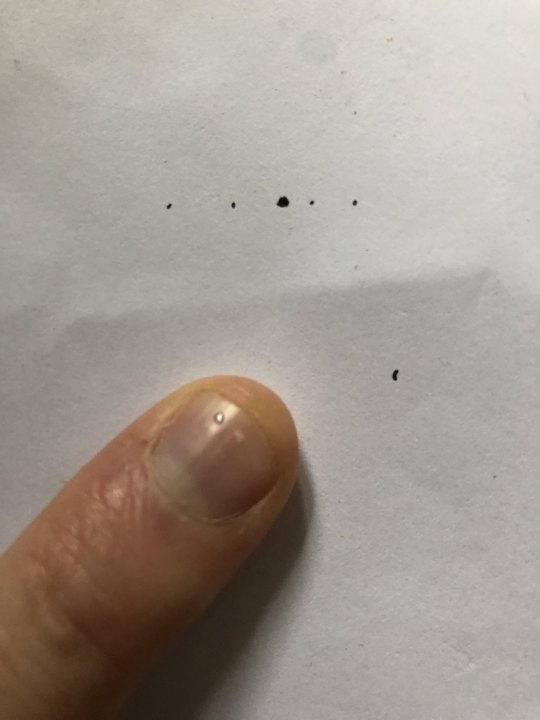
(Finger for scale)
Since the real planets are too big, I made my own. Jupiter is the big dot on top, the four small dots around it being its four biggest moons. Venus is the little crescent to the right of my finger. I made both planets about a millimetre in diametre, which means Venus is at a 1 in 12.1 billion scale and Jupiter at a 1 in 142 billion scale. Which means I need to view them both from a little over 4 metres away to get a realistic view of them at closest approach (Jupiter) or a close-enough-to-not-be-in-front-of-the-Sun approach (Venus).
The first result I noticed was how clearly the Galilean moons were in fact separate from Jupiter. I had no problem distinguishing between them and, given that they are just bright enough, I really do wonder if Callisto at least might be distinguishable during a very dark and clear night too. Jupiter itself also did look more substantial than the mere points of its moons, presenting what was fairly clearly a disk rather than a point. Now, whether I can see Venus's crescent shape is trickier to say. It felt like something that was juuust on the edge of my vision, like I could just make out a hint of oblongness to the dot, but maybe that's just because I knew it was supposed to be a crescent and my brain was filling in what my eyes couldn't tell me. Coming a little closer, it was fairly obvious from 3 metres away, but that's closer than Earth and Venus ever get at this scale.
So in conclusion, Venus's crescent shape, Jupiter's disk, and its moons, might all be possible to discern with the naked eye if the night sky was a perfect vision test environment. Since it's not, aim your binoculars their way to enjoy those things instead!
#vicky's vritings#astronomy#space#venus#jupiter#galilean moons#i considered doing a test for saturn's rings too#but i would either have to draw even smaller#or get a bigger house#i do not have the space to view a 1 mm saturn from 10 metres away#also it seems unlikely to yield success given how close to the edge of my vision the venus and jupiter tests were
1 note
·
View note
Text
In preparation of a new post I'm writing up about Lepidodendron and what an oddity it was, I made a tag for #vicky's vritings so my various ramblings can be dug up from my reblog storm a little easier!
#digging up the posts made me realise how much museumposting i've done too#i really should go and tag those#but that'd be soooo much work
1 note
·
View note
Text

Thinking about Paranthropus.
They're these extinct hominins who, like us, probably descended from Australopithecus about 2.8 million years ago, and didn't go extinct until about 600000 years ago, meaning they lived on the planet alongside our own ancestors Homo habilis, erectus, and heidelbergensis. But unlike them, Paranthropus continued to have Australopithecus's more ape-like features and didn't start evolving big ol' noggins. In fact, they had big arms like orang-utans and were probably amazing tree climbers. They did, however, walk on two legs, use bone tools (and presumably wood, but those don't fossilise), and may even have figured out how to keep fires from lightning and such going for their own purposes.
I'm thinking about how 600000 years isn't all that long ago and what they would've been like if they were still around. We share a common ancestor with chimps 7 million years ago and with Paranthropus only 2.8 million years ago, so they'd be the species nearest related to us by far. In a world where they survived, we'd probably just think of them as the closest of the great apes, more like us than chimps and gorillas, but otherwise just a cool animal. But on the other hand, if there's an animal out there that walks on two legs, regularly uses tools and maybe even fire, that poses a lot of questions about where we come from and how we should treat them. More so than the great apes already do. I can't help but feel it would ethically be very uncomfortable to go to a zoo and have them be like 'and here's the enclosure where we keep these strange hairy men who use sticks to dig for and cut up their food. They like to stay warm and sometimes roast their meal so we lit them a little campfire when we first got them and they've kept it going themselves'. But then again, us treating the great apes this way is already rather questionable.
Paranthropus seems to have been rather big and robust, so they may have looked as much like a gorilla as a human. They had big, strong climbing arms like orang-utans and gibbons, our more distant relatives. Neither of these traits were especially present in Australopithecus, our common ancestor, and that's something I find very interesting too. It's important to remember that humans are not the final product or the peak of evolution, that it didn't all have to lead to us, with the species 'branching off' along the way staying in unproductive stasis that kept them the same as our common ancestor. Chimpansees are not our actual ancestors, they've had their own evolutionary path, one that we know way less about than our own, over the past seven million years. Paranthropus didn't stop evolving, they went their own way, which included gaining some traits more distant relatives have.
We'll probably never know what they were really like, as there's so much that just doesn't fossilise. We think they were probably furry and didn't use language, but then again, we just don't know. How much were their lives and groups like those of chimps and gorillas?
Human evolution is very interesting, and Paranthropus got me thinking about it again. We didn't have to end up on a somewhat isolated branch of the tree of life, with our nearest living relatives seven million years away. There could've just as easily been a closer branch or two surviving alongside us, and until pretty recently, there was.
#paranthropus#human evolution#paleontology#hominids#biology#apes#cw: skull#there's no real point to this post#it's just a collection of thoughts#i just wish they were still around#they'd be so interesting#them being our cousins and not our ancestors in a way makes them even more fascinating#palaeoblr#vicky's vritings
33 notes
·
View notes